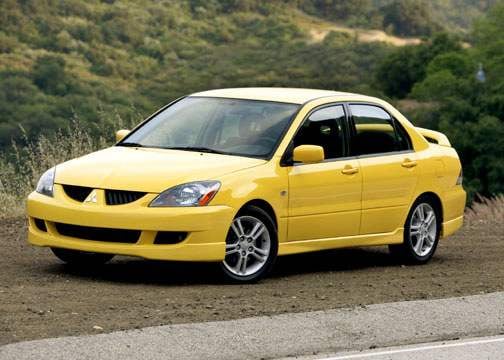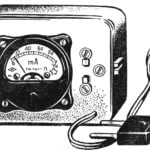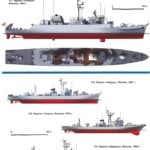 Mitsubishi Lancer 2005 issue. My first meeting with the Mitsubishi Lancer took place at the uncontrolled intersection. Thump in the left door of my “Fields”, the gnashing of metal on metal, squeaking brakes and… silence. The driver of a new “Japanese” was the young lady that turned out to be only the second time in my life independently drove his car to the “big world” — and on a day she was clearly not up to the sign “give way”.
Mitsubishi Lancer 2005 issue. My first meeting with the Mitsubishi Lancer took place at the uncontrolled intersection. Thump in the left door of my “Fields”, the gnashing of metal on metal, squeaking brakes and… silence. The driver of a new “Japanese” was the young lady that turned out to be only the second time in my life independently drove his car to the “big world” — and on a day she was clearly not up to the sign “give way”.
A cursory inspection of the “battlefield” showed that rammed me Lancer escaped the demolished front room and a small dent on the hood, but my “field”… Dented the door deformed the door and irreparably damaged the front wing.
Disequilibrium losses sparked my interest in this solid car, ordinary at first glance. And later, in 2005, interest in this machine has been fuelled by news that Mitsubishi Lancer proclaimed in Russia “Car of the year”, was to the same and the sales leader in its class.
Japanese industrial concern Mitsubishi was founded back in the nineteenth century — in 1870. In 1917, it appeared the automotive sector, and three years later — and aircraft production.
The first company car was a passenger car model “A” representing a copy of the “Italian” FIAT Zero 1912 issue. Serial production was hard to call the Mitsubishi group managed to make only two dozen of these machines.
In subsequent years, the plants produced only Mitsubishi trucks Yes buses, and only in 1934 was an attempt to create all-wheel drive passenger car RH-33.
To expand the production of passenger cars was only in the late 1950-ies. The first machine of that time, released in 1959, became a four-cylinder sedan with a 0.5-liter air-cooled engine. In the next decade, Mitsubishi Motors has continued to produce a small car, so popular at that time in Japan — Mitsubishi Colt and Mitsubishi Minica.
The transition to a full European car classes emerged in the 1970-ies — in the production program of the group cars with engines of 1.1 and 1.2 L. One of the most purchased cars of that period was a medium-class sedan Mitsubishi Galant (by the way, in the US it was badged as Dodge). In the same decade, in 1973, was created and the vehicle, which was later destined to become the sales leader in many countries — including in Russia — Mitsubishi Lancer with engines working volume of 1.2 — 1.5 L.

Mitsubishi Lancer first generation (1973)

Mitsubishi Lancer second generation (1978)
In 1980-ies the basis of the production program of Mitsubishi Motors were the three most popular car — the three-door Mitsubishi Colt, Mitsubishi Lancer four-door and a middle class car Mitsubishi Galant.
Currently, Mitsubishi Motors manufactures passenger cars of almost all known classes and types — miniature Mitsubishi Minica, model small Lancer and Colt subcompact cars Carisma and Galant, and also Executive cars — Mitsubishi Diamante/ Sigma and Mitsubishi Debonair with V6 engines working volume of 2.5 — 3.5 liters.
An important role in the production program of Mitsubishi Motors play-wheel-drive cars, the first of which was released in 1982, the Mitsubishi Pajero. Specifically for the Japanese market produced a reduced model Pajero — Mini and Junior. In the late 1990-ies appeared and enlarged version of the Pajero — Challenger (Montera) which differs by more the 5-door body and is continuously enabled to drive the front and rear wheels.
However, today we will talk about the model-class Golf Mitsubishi Lancer, one of the most popular cars of the company. As already mentioned, for the first time the name of Lancer (in translation from English — “Ulan”) appeared at cars of Mitsubishi company in 1973. The first decade of the release of the Lancer was rear-wheel drive, and only since 1982, these machines have a front-wheel drive.

Mitsubishi Lancer third generation first got front-wheel drive (1982)

Mitsubishi Lancer of the fourth generation (1983)

Mitsubishi Lancer of the fifth generation (1988)

Mitsubishi Lancer seventh generation (1995)

The latest Mitsubishi Lancer 2005
In 1992 it was released for the fourth generation model called the Lancer, equipped with petrol engines working volume of 1.3 l (75 BHP), 1.6 l (113 HP) and 1.8 l (135 HP) and 88-horsepower 2-liter diesel engine. A year later, was put into series production car with a body “universal”.
In 1996 was launched the fifth generation Mitsubishi Lancer. Transformed both the interior and exterior appearance, but its design is virtually unchanged. In the same year of the cars with the Lancer wagon was manufactured with four-wheel drive transmission. In 1998 he was made a minor revision of the exterior of the car.
In 2003, on the European market a new generation Lancer, which is a converted model of Mitsubishi Lancer Cedia (the so-called car in the Japanese market). However, here again modernization has affected mainly the exterior and interior — all the mechanics are virtually unchanged. An unbroken chain of sound of evolution — the so-called company policy to improve the models, preserving the positive features and deficiencies.

Geometric diagram of the Mitsubishi Lancer

Mitsubishi Lancer is equipped with multi-link rear suspension with effect of passive flanking rudder equipped with stabilizer bar

Mitsubishi Lancer: from the frame to the car

As an option, the Lancer can be fitted with a spoiler
The machine comes in four flavors — sedan, the Lancer is 1.3 Comfort petrol 82 HP engine displacement 1299 cm3, sedan Comfort 1.6 and Lancer wagon Lancer 1,6 Comfort petrol 98-strong engine working volume of 1584 cm3 and wagon Lancer has a 2.0 petrol Sport with a 135-horsepower engine displacement of 1997 cm3. All engines are 16-valve.
The motors have quite a decent pick — up- acceleration from 0 to 100 km/h — 10 s (in cars with 2-liter engine) to 13.7 (at cars with 1.3 liter engine). However, independent testers claim that the variant with 1.3-liter engine is virtually identical to the model with 1.6-litre power unit. Fast and dynamic universal with 2-liter engine, but his character is far from sports — set it to 135-HP engine are as calm and balanced, and less powerful motors, which are equipped with Mitsubishi Lancer.
All versions are equipped with a mechanical 5-speed gearbox with a very clear and easy switch that allows drivers to get satisfaction from dynamic drive. Models with 1.6-liter engine can be equipped with a Quad-automatic transmission INVEX-II Sport Mode, able to adapt to the individual characteristics of the driver’s control. In Sport Mode you can change gears in manual mode.
Mitsubishi Lancer suspension front — independent, spring, type McPherson, with stabilizer. The rear is also independent, multilink, with stabilizer. Claim that experts Mitsubishi Motors has achieved perfection in designing and fine-tuning of suspensions, which is confirmed by numerous victories of the legendary Lancer Evolution sports version of the Mitsubishi Lancer — in the Championships of the world rally championship.

The driver

The interior of the car Lancer
Rigid and durable chassis provides a Lancer reliability for the road with any surface, from dirt road to asphalt, creating for the driver and passengers comfort and smoothness. The combination of well configured independent suspensions of all wheels and steering with progressive characteristic ensures optimum handling, high stability, no excessive body roll and therefore active safety the Lancer on any roads. Besides, front and rear stabilizer bars eliminate the buildup of the body and reduce the rolls.
Machine extremely clearly “prescribes” the turns without creating undue stress driver attention and effort. By the way, the steering wheel is adjustable in angle of inclination in accordance with the individual characteristics of the driver.

The 2005 Mitsubishi Lancer has become the “Car of the year” and sales leader in the Golf class thanks to the optimal ratio of price and quality
The machine is equipped with a range of systems that increase active safety. Among them — reliable anti-lock braking system the ABS is able to prevent the loss of stability when braking on a slippery road and EBD (Electronic Distribution Brace), increasing the brake efficiency using the optimal distribution of brake forces between front and rear wheels at any vehicle load. The brakes both front & rear — disc: front 15-inch vented, rear — 14 inch.
Collision car accidents in the struggle for life crew join SRS airbag (driver and front passenger), front three-point safety belts with pretensioners, and collapsing collapsible steering column, “leaving” in accidents of the driver. And to secure child seats the rear seat is supplied with reinforced anchorages ISOFIX.
Technical characteristics of the car Mitsubishi Lancer

As already mentioned, the 2005 Mitsubishi Lancer has become in Russia the leader of sales among foreign cars. The reason for this is very attractive ratio “price — quality”: in 2006, the “cheap” Lancer, which cost 14 $ 450, had the standard equipment Central locking, air conditioning, Immobiliser, power steering, adjustable steering column, electric mirrors, electric Windows, airbags for driver and front passenger, ABS velour interior — all of it, Lancer, unlike many machines of the class assembled in Russia, — fully imported car which is produced at the plant of Mitsubishi Motors in the Japanese city of Mizushima.
Not so often, readers of “Modeller-designer” found in the pages of the magazine with cars from the land of the rising sun. With Mitsubishi — perhaps for the first time. And it is good that this car became popular in Russia Lancer is a modest and inconspicuous at first glance, the car-class Golf, whose design has incorporated all achievements of the famous Japanese car company.
I. EVSTRATOV



